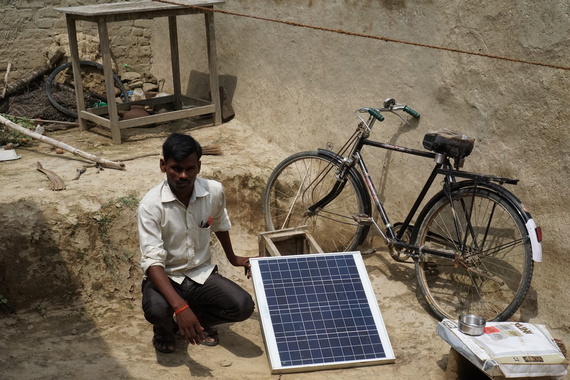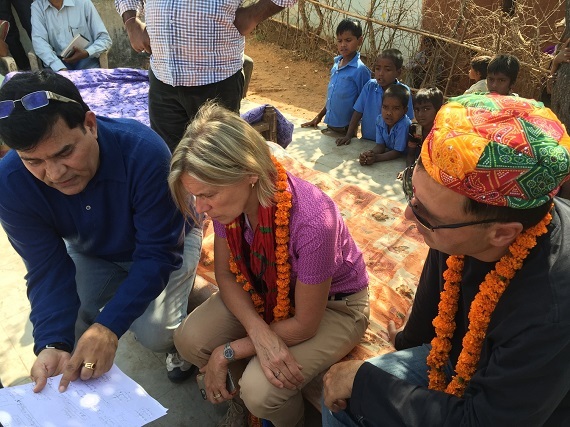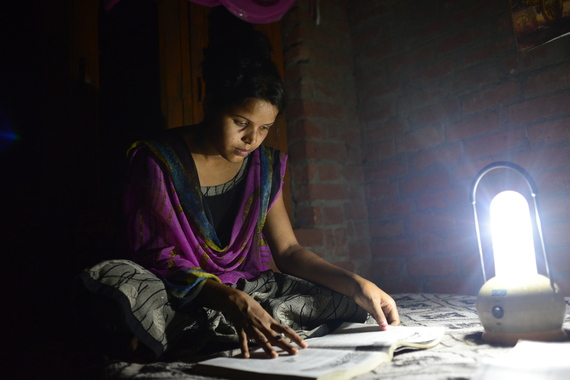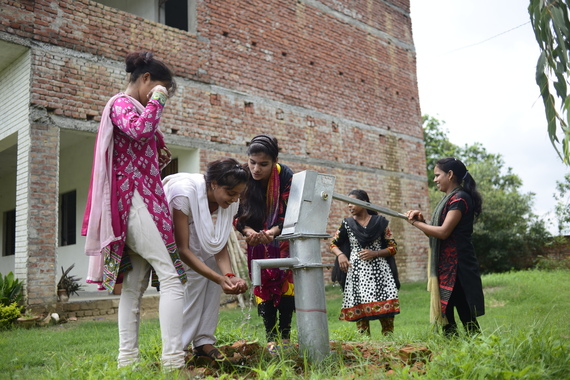Late last year my colleagues and I visited a remote village in rural Rajasthan, India. We were greeted by village leaders offering fresh flower garland necklaces while a joyous collection of enthusiastic, young boys beat drums and tins of all sizes in the background. Following a few moments of warm "Namastes," we were escorted up the path to a terrace adjacent to the village's central building where we participated in a town hall meeting. To discuss what? Bringing electricity for the first time to this community of 400 families.
Solar is the solution. Solar panels are the fastest-to-deploy, most cost-effective and cleanest electricity option available to bring electricity to villages like this one and provide essential, basic services, including clean water, pumps, light, refrigeration, and connectivity. To many of us in developed countries, the simple concept of light is taken for granted. Flip a switch, right? In many parts of the developing world there are no "switches" - to get light, you must burn diesel or kerosene, both of which produce harmful emissions. In fact, kerosene lamps lead to 1.5 million deaths per year - more than five times the annual malaria deaths. Simply replacing those kerosene lamps with solar-powered lamps would save more lives than eliminating malaria.
My company, SunEdison Frontier Power, is in the business of building solar-powered mini-grids in villages like this one. We design, construct and operate rural utilities that offer communities light, water pumping, phone charging, refrigeration, connectivity and other modern amenities. Children can study at night. Water can be purified. Medicines and food can be kept cold. Businesses can expand their operating hours. While this has terrific community benefits, both in terms of human health and the economy, it isn't charity. The villagers and local businesses - in this case a flour mill and several shops - pay us for the power they consume. And at the town hall meeting in Rajasthan that day, there was overwhelming support for doing just that: the town agreed that the solar-powered mini-grid should be built. We will be starting construction early next year.
Access to non-polluting electricity in the developing world is mission-critical for enabling health and preventing disease, as well as in facilitating commerce. Over 1.3 billion people are completely without power; another billion have electricity for just a few hours a day. The economic upshot is clear: a recent International Monetary Fund report names "severe" electricity shortages as a significant contributor to Sub-Saharan Africa's reduced economic growth. The sooner the developing world gains greater access to cost-effective clean energy, the quicker these issues will be alleviated. And it all starts with solar power.
In many remote areas, solar power is now more cost effective than diesel or kerosene. With solar now cheaper than kerosene, we can eradicate kerosene lamp deaths and remove the health impacts of burning fuel inside and around homes. By offering cost-effective electricity we can deliver other essential services and catalyze the growth of local economies - without waiting for power plants and transmission lines to be built. It takes only a few months to power a village with a solar mini-grid, whereas extending the electrical grid frequently takes several years.
Just as remote areas leapfrogged wire phone lines for mobile phones, solar can leapfrog the old way of providing electricity by skipping the capital-intensive, centralized power plants and long-distance transmission infrastructure. Solar has been used for decades, often paired with batteries, for a range of remote applications, from telephone stations on mountain tops to villagers requiring water pumping. Today a local solar mini-grid can help provide reliable internet services as well, supporting businesses, clinics, schools and families.
As a global society it is in our collective best interest for the developing world to "develop" in a way that is economically and environmentally sustainable. We want to improve health, build economies and save lives. We want to do this as fast, effectively and cheaply as possible. Looking at the numbers, these objectives add up to solar as an answer. As countries continue to work through the best ways to address climate change, we are hopeful that they realize that reducing greenhouse gas emissions needn't mean stifling growth or compromising health in developing economies. The opposite is true. Reducing carbon, improving health, enabling commerce and securing access to clean energy are not mutually exclusive; they are in fact, inextricably intertwined.



